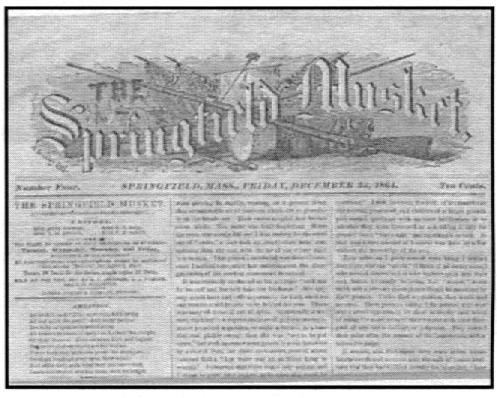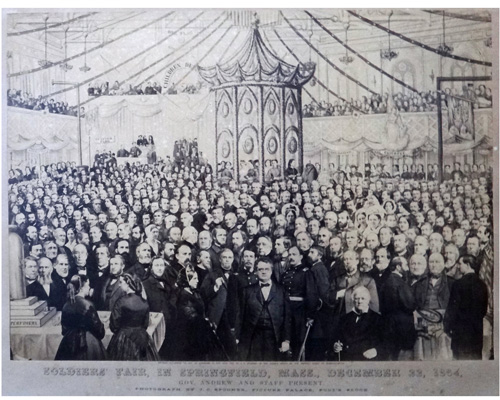|
Springfield Soldier's Fair
By Spencer Janes, Summer 2011 Intern- Longmeadow
Historical Society
During the heart of the Civil War in
late 1864, the people of Western Massachusetts came
together to support the efforts of the Union troops.
They did this not only through personal sacrifice or
hard work, but by throwing and attending a massive fair.
 In 1861, with the approval of
President Lincoln, a group of concerned Northerners
formed the United States Sanitary Commission. This
commission was largely driven by the efforts of women
volunteers (including author Louisa May Alcott and
reformer Dorothea Dix) who helped to raise supplies,
provide lodging and meals, inspect the health standards
of Union camps and oversee medical care for the Union
troops. In 1861, with the approval of
President Lincoln, a group of concerned Northerners
formed the United States Sanitary Commission. This
commission was largely driven by the efforts of women
volunteers (including author Louisa May Alcott and
reformer Dorothea Dix) who helped to raise supplies,
provide lodging and meals, inspect the health standards
of Union camps and oversee medical care for the Union
troops.
Starting with the Northwestern
Soldiers' Fair in Chicago in the fall of 1863, northern
cities held dozens of fairs to raise money for this
organization. Western Massachusetts did not escape this
phenomenon, and in December of 1864, the Soldiers' Rest
of Springfield held a "Great Soldiers' Fair" which would
involve all of the surrounding communities and raise
upwards of $18,000 for the cause. Longmeadow residents
Thomas G. Mather and Randolph Stebbins served on the
general committee which planned this fair and Longmeadow
resident John R. Stebbins served on the appraisal
committee to determine the prices of various items sold
and auctioned off during the fair.
Opening on Monday, December 19th,
1864, the Springfield Soldiers' Fair ran for five days
and was an immense success. Despite harsh winter
weather and the busy holiday season, crowds flocked to
the fair with each day seeing more attendees packed into
the hall.
Tables from each of the outlying
towns showcased their unique communities, including a
large table from Longmeadow. Visitors marveled at the
beautiful floral arbor and purchased commemorative
silver medallions from a nearby stand. The fair also
included a skating rink, an "Old Curiosity Shop", and an
extensive art gallery. This gallery contained works
donated or created by area citizens, which were
auctioned off at the end of the fair for proceeds of
$530. There was even a newspaper,
The Springfield Musket, is published in four
installments, just for the occasion.


Most of the items donated to the fair
were disposed of in auctions or raffles, which generated
a good amount of the fair's proceeds. The governors of
Massachusetts and Vermont both wrote letters to the fair
organizers, as did President and Mrs. Lincoln, which
were sold at auction. Much of the more than 1300 worth
of items contributed by Longmeadow residents were given
away in the raffles, which the Springfield Republican
deemed to be inappropriate and "all very wrong, of
course." Longmeadow donations such as a silver salt
cellar worth $15 and bronze figures worth $30 helped
this cause. Longmeadow residents were also the
beneficiaries of these raffles since Mr. Sylvester Bliss
won a $20 sofa cushion and F.D. Cordis won a watchcase.

[click photo to enlarge]
Estimates indicate that the efforts
of this fair ultimately helped over 17,000 soldiers and
families by providing much needed medical care,
transportation, food, and clothing. The entire region
came together for this cause, and Longmeadow
especially. Longmeadow's donations far exceeded those
of other communities and Longmeadow citizens no doubt
graced the fair with their presence and their money.
|

